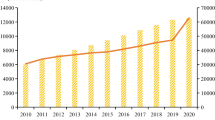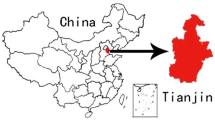Abstract
Low-carbon transition has gradually become the focus of research on environmental issues. This paper takes China’s eight major economic regions as the entry point. First, carbon emissions are measured according to United Nations’ baseline methodologies. Second, the stochastic nonparametric data envelope analysis (StoNED) model is used to measure energy efficiency to improve the accuracy of the measurement. Finally, considering the temporal and spatial nonstationarity of carbon emission data, this paper constructs geographically and temporally weighted regression-stochastic impacts by regression on population, affluence, and technology (GTWR-STIRPAT) model, which can accurately analyze the impact of each driving factor of carbon emissions. This paper also explores efficient emission reduction paths in conjunction with the forcing mechanism. According to the study, China’s carbon emissions show a decreasing trend from coastal areas to inland areas. In addition, there are significant problems with carbon emissions in China: some regions focus on improving energy efficiency but neglect increasing energy consumption; some regions focus on industrial development but neglect long-term emission reductions. Among the driving factors, energy efficiency, foreign trade, environmental regulations, and industrial structure have the effects of spatiotemporal heterogeneity, spatial heterogeneity, and time lag on carbon emissions, respectively.

Graphical abstract






Similar content being viewed by others
Notes
Due to the poor availability of data in the Tibet Autonomous Region, Taiwan Province, Hong Kong and Macau Special Administrative Regions, they were not included in the study.
It is based on the spirit of “Several Opinions of the Central Committee of the Communist Party of China and the State Council on Promoting the Rise of the Central Region”, “Implementation Opinions of the State Council on Several Policies and Measures for the Development of the Western Region” and the report of the 16th National Congress of the Communist Party of China.
References
Deng XL, Yan ZM, Wu YY (2014) Does the inverted-U shaped relationship between carbon emission and economic development exist?——the reexamination of environmental Kuznets curve hypothesis. Financ Econ (02): 19-29. https://doi.org/10.19795/j.cnki.cn11-1166/f.2014.02.004
Ding BG, Yang SW, Zhao Y (2019) Temporal and spatial characteristics and driving factors of carbon emissions from planting industry in the Yangtze River economic belt. J Ecol Rural Environ 35(10):1252–1258. https://doi.org/10.19741/j.issn.1673-4831.2019.0158
Fan D (2013) Driving factors of carbon emissions from energy consumption in China-based on LMDI-PDA method. China Environ Sci 33(09):1705–1713
Dong F, Li JY, Zhang SN, Wang Y, Sun ZY (2019) Sensitivity analysis and spatial temporal heterogeneity of CO2 emission intensity: evidence from China. Resour Conserv Recycl 150. https://doi.org/10.1016/j.resconrec.2019.06.032
Goldstein GA (1995) Markal-macro: a methodology for informed energy, economy and environmental decision making. Office of Scientific & Technical Information Technical Reports, Informal report. https://doi.org/10.2172/90675
Hu BD (2014) Measuring plant level energy efficiency in China’s energy sector in the presence of allocative inefficiency. China Econ Rev 31:130–144. https://doi.org/10.1016/j.chieco.2014.08.011
Hu XF, Wang XH, Wu S (2019) Research on carbon emission and the driving factors of logistics industry in Yangtze River. Economic. Ecoeconomics 35(07):49–55
Huang Y, Chen XC (2019) Foreign trade, economic growth and carbon emissions in China—empirical research based on quantile regression. Econ Math 36(04):75–81. https://doi.org/10.16339/j.cnki.hdjjsx.2019.04.012
Huang B, Wu B, Barry M (2010) Geographically and temporally weighted regression for modeling spatiotemporal variation in house prices. Int J Geogr Inf Sci 24(03):383–401. https://doi.org/10.1080/13658810802672469
Jiang GH, Guo P (2013) Impact of FDI regional disparities on regional disparities of carbon emissions. China Popul Resour Environ 23(03):98–104. https://doi.org/10.3969/j.issn.1002-2104.2013.03.016
Jiang H, Zhao BF (2015) Non-linear dynamic relationship between energy efficiency changes and industrial structure evolution from a low-carbon perspective: based on panel data from 1990 to 2012. Explor Econ Issues 07:68–76
Jondrow J, Lovell CAK, Materov IS, Schmidt P (1982) On the estimation of technical inefficiency in the stochastic frontier production function model. J Econ 19(2-3):233–238. https://doi.org/10.1016/0304-4076(82)90004-5
Kuosmanen T (2006) Stochastic nonparametric envelopment of data: combining virtues of SFA and DEA in a unified framework. Discussion Papers 3. https://doi.org/10.2139/ssrn.905758
Li YL (2020) Fiscal pressure, land finance and the spatio-temporal evolution of regional house price—empirical research based on GTWR model. Public Financ Res (05):78–89. https://doi.org/10.19477/j.cnki.11-1077/f.2020.05.006
Li Q, Wei W (2015) Research on total factor energy efficiency and its influencing factors under carbon emission constraints perspective. Soft Sci 29(04):71–74. https://doi.org/10.13956/j.ss.1001-8409.2015.04.16
Li JX, Chen YN, Li Z, Liu ZH (2018) Quantitative analysis of the impact factors of conventional energy-carbon emissions in Kazakhstan based on LMDI decomposition and STIRPAT model. J Geogr Sci 28(07):1001–1019. https://doi.org/10.1007/s11442-018-1518-5
Li EK, Lu YQ, Chen Y (2019) Geographic pattern evolution of China's merchandise export and its influencing factors: based on the analysis of merchandise export distance and the GTWR model. Geogr Res 38(11):2624–2638. https://doi.org/10.11821/dlyj020181007
Lin B, Xu B (2018) Growth of industrial CO2 emissions in Shanghai city: evidence from a dynamic vector autoregression analysis. Energy 151):167–177. https://doi.org/10.1016/j.energy.2018.03.052
Liu JJ, Li XH, Shi D (2013) Study on the shift of CO2 emissions gravity center and driving factors. Financ Econ (12):112–123. https://doi.org/10.19795/j.cnki.cn11-1166/f.2013.12.018
Lu WW, Su MR, Zhang Y, Yang ZF, Chen B, Liu GY (2014) Assessment of energy security in China based on ecological network analysis: a perspective from the security of crude oil supply. Energy Policy 74):406–413. https://doi.org/10.1016/j.enpol.2014.08.037
Ma XJ, Li YD, Wang CX, Yu YB (2018) Ecological efficiency in the development of circular economy of China under hard constraints based on an optimal super efficiency SBM-Malmquist-Tobit model. Chin Environ Sci 38(09):3584–3593. https://doi.org/10.19674/j.cnki.issn1000-6923.2018.0387
Ma XJ, Chen RM, Dong BY, Niu XQ (2019) Factor decomposition and decoupling effect of China’s industrial carbon emissions. China Environ Sci 39(08):3549–3557. https://doi.org/10.19674/j.cnki.issn1000-6923.2019.0421
Meng C, Chen YJ (2012) China’s inter-regional energy efficiency during the period of 1995-2010: descriptive statistic and DEA analysis based on provincial panel data. Financ Econ (06):116–123. https://doi.org/10.19795/j.cnki.cn11-1166/f.2012.06.017
Pang QH, Zhou MM, Yang TT (2020) Research on the influence mechanism of carbon emission, industrial structure and environmental regulation in the Yangtze River economic belt. Ind Technol Econ 39(02):141–150. https://doi.org/10.3969/j.issn.1004-910X.2020.02.017
Shen N, Liu FZ (2012) Can Intensive environmental regulation promote technological innovation? Porter hypothesis reexamine. Soft Sci China 04:49–59. https://doi.org/10.3969/j.issn.1002-9753.2012.04.006
Shen Y, Wang CC, Gao C, Ding L (2020) Temporal and spatial distribution of carbon emissions and its influencing factors in the economic zone of the Zhejiang bay area based on urbanization. J Nat Resour 35(02):329–342
Su K, Chen YH, Fan SS, Zhang MM (2019) Influencing factors and reduction mechanism of carbon emissions at the city-range: an empirical study on Fujian province. China Environ Sci 39(02):859–867. https://doi.org/10.19674/j.cnki.issn1000-6923.2019.0105
Tsai Y, Ko Y, Huang M et al (2014) CHI3L1polymorphisms associate with asthma in a Taiwanese population. BMC Med Genet 15:86. https://doi.org/10.1186/1471-2350-15-86
Wang F (2018) Development trend of the study on China’s carbon emission peak and its forcing mechanisms. China Popul Resour Environ 28(02):141–150
Wang B, Hou BQ (2017) Empirical study of regional green development performance in China: 1998—2013—based on global non-radial directional distance function. J China Univ Geosci (Soc Sci Ed) 17(06):24–40. https://doi.org/10.16493/j.cnki.42-1627/c.2017.06.004
Wang HX, Wang JD, Huang B (2012) Prediction for Spatio-temporal Models with Autoregression in Errors. J Nonparametr Stat 24. https://doi.org/10.1080/10485252.2011.616893
Wang X, Yue YD, Liu GC (2013) The impact of technological environment on energy efficiency of central region based on a stochastic frontier analysis model. Econ Geogr 33(05):37–42. https://doi.org/10.15957/j.cnki.jjdl.2013.05.006
Wang YN, Zuo YH, Chen W, Wang BW (2018) Threshold effect and regional differences of environmental regulation on carbon emission. Environ Sci Res 31(04):601–608. https://doi.org/10.13198/j.issn.1001-6929.2017.03.92
Wu XY (2008) Forced mechanism: government action for enterprise innovation motive. J Natl Admin Inst (06):51–54. https://doi.org/10.14063/j.cnki.1008-9314.2008.06.024
Wu XY, Shao J (2016) The influence of import openness on manufacturing energy efficiency in China—an empirical study based on tariff reduction. Financ Econ (06):82–96. https://doi.org/10.19795/j.cnki.cn11-1166/f.2016.06.007
Wu B, Li R, Huang B (2014) A geographically and temporally weighted autoregressive Model with Application to Housing Prices. Int J Geogr Inf Sci 28(5):1186–1204. https://doi.org/10.1080/13658816.2013.878463
Xi YL, Ji SB, Wang XY (2013) Reverse transmission of relative factor price on industrial structure adjustment: on system GMM test of inter-provincial panel data. Financ Trade Res 24(05):18–24. https://doi.org/10.19337/j.cnki.34-1093/f.2013.05.003
Yang Q, Liu HJ (2015) Regional disparity and influencing factors of agricultural water resources efficiency with the constraint of pollution. Res Quant Econ Technol Econ 32(01):114–128+158. https://doi.org/10.13653/j.cnki.jqte.2015.01.008
Yang WT, Huang HK, Wei DS, Zhao B, Peng HH (2020) Spatio-temporal variation of PM2.5 related relationships in China from the perspective of air pollution regional linkage control and prevention. 41(5):2066–2074. https://doi.org/10.13227/j.hjkx.201908125
York R, Rosa EA, Dietz T (2003) STIRPAT, IPAT and ImPACT: analytic tools for unpacking the driving forces of environmental impacts. Ecol Econ 46(3):351–365. https://doi.org/10.1016/S0921-8009(03)00188-5
Zha DL, Zhou DQ, Sun Y (2013) Why do the energy efficiency on reduction and carbon emission increase simultaneously. Syst Eng 31(10):105–111
Zhao JL, Li G, Su Y, Liu JG (2013) Regional differences and convergence analysis of energy efficiency in China: on stochastic frontier analysis and panel unit root. China Manag Sci 21(02):175–184
Zhao GM, Zhao GQ, Chen LZ, Sun HP (2017) Research on spatial and temporal evolution of carbon emission intensity and its transition mechanism. China Popul Resour Environ 27(10):84–93. https://doi.org/10.12062/cpre.20170609
Zheng Y, Xu KN (2013) Analysis of the driving factors for changing carbon emission in China. Financ Econ (02):124-136. https://doi.org/10.19795/j.cnki.cn11-1166/f.2013.02.013
Zhou CJ (2002) The endogenous money supply and the monetary policy in China. J Nanjing Univ (Philos Humanit Soc Sci) 39(01):72–82. https://doi.org/10.3969/j.issn.1007-7278.2002.01.009
Zhu ZJ, Wei JF, Tian WJ (2018) Contrastive analysis of the impact of urbanization on carbon emissions in different regions of China. Xinjiang Agric Reclam Econ 12:27–34. https://doi.org/10.3969/j.issn.1000-7652.2018.12.005
Funding
This work was supported by the National Social Science Fund of China (grant numbers 18AGJ003, 19BTJ054), Scientific Research Project of Liaoning Provincial Department of Education (grant number LN2020Z02).
Author information
Authors and Affiliations
Contributions
Conceptualization, Jingquan Chen. Formal analysis, Baishu Chang. Writing (original draft), Xinyan Lian and Baishu Chang. Writing (review and editing), Hanning Su. Project administration, Xiaojun Ma. Supervision, Jingquan Chen and Xiaojun Ma. Investigation, Ziyan Zhang.
Corresponding author
Ethics declarations
Competing interest
The authors declare that they have no competing interest.
Ethics approval and consent to participate
Not applicable.
Consent for publication
Not applicable.
Availability of data and materials
The datasets generated and analyzed during the current study are not publicly available but are available from the corresponding author on reasonable request.
Additional information
Responsible editor: Philippe Garrigues
Publisher’s note
Springer Nature remains neutral with regard to jurisdictional claims in published maps and institutional affiliations.
Rights and permissions
About this article
Cite this article
Chen, J., Lian, X., Su, H. et al. Analysis of China’s carbon emission driving factors based on the perspective of eight major economic regions. Environ Sci Pollut Res 28, 8181–8204 (2021). https://doi.org/10.1007/s11356-020-11044-z
Received:
Accepted:
Published:
Issue Date:
DOI: https://doi.org/10.1007/s11356-020-11044-z




